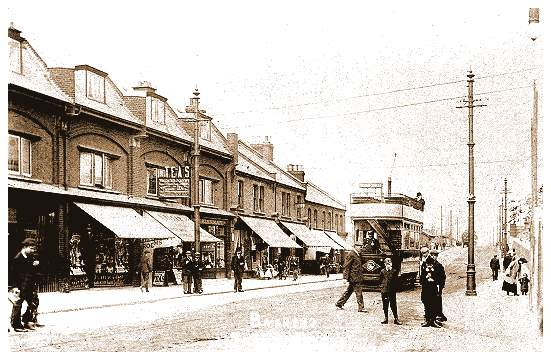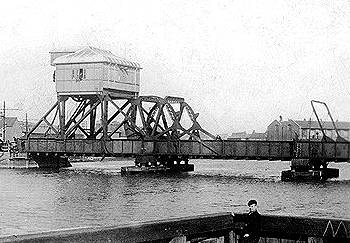

The town of Barking in Essex, to the east of London, had perhaps the least successful of all the London tramways. Our main postcard shows car 4 in East Street in about 1910. It was published locally by J.Worricker. This is an original postcard from the period, but card collectors should be aware that in the early 1960s Mr Worricker, who then owned a small toy shop in East Street, produced a series of photographic views of "Old Barking" from the same negatives. The smaller view below is an extract from a postcard of an unknown publisher.
The Barking Town Urban District Council Light Railways began service on 1st December 1903 with the opening of a single track route southwards from Axe Street near the town centre to Beckton Gas Works (the opposite end of the works to that served by the East Ham Tramways and today by the Docklands Light Railway), via Gascoigne Road, a bridge across the River Roding, and Jenkins Lane. The depot was at Beckton. In 1905 a short line was laid in the west from the terminus of East Ham tramways in London Road to Barking Broadway and along East Street to the east side of Barking Station to be worked by East and West Ham cars, and another in the north from the Ilford tramway at the borough boundary at Loxford Bridge along Fanshawe Avenue and Longbridge Road to the west side of Barking Station worked by Ilford trams. The three lines were not connected. In 1907, after the building of a bridge crossing the railway at the station and an extension at Axe Street, the three lines were joined up and Barking took over the service to Loxford Bridge with a service from Fisher Street (near the Roding), bringing the system length to about two miles. In 1910 East Ham, West Ham and Barking began a joint service from Barking Station to Iron Bridge Poplar and in 1912 with the addition of the LCC trams a service from Loxford Bridge to Aldgate, soon numbered 69. In 1914 Barking withdrew from the joint working and from then on the other operators continued the services from London to Barking Broadway, with Ilford Corporation taking over operation of services from Barking Broadway to Ilford, leaving Barking just to operate the lone route to Beckton.
Car 4 in our view was one of a batch of seven 4-wheel trams built by the Brush Electrical & Engineering Co. at Loughborough for the opening of the tramway in 1903. They were open top and had 51 seats. They were mounted on 6ft. wheelbase Peckham Cantilever type 9A trucks, converted to 10A 7ft. wheelbase in 1911. They had two General Electric G.E.54 motors and B.T.H. controllers. Cars 1-3 and 7 were soon fitted with Milnes Voss "Bellamy" type top covers, but 1-3 had them removed in 1922 due to poor condition. In 1912 top covered cars were fitted with plough carriers at East Ham depot, for working the Barking-Aldgate though service. For the same reason Brush supplied new open balcony cars 8 & 9 on Peckham R7A 7ft wheelbase radial trucks in 1911 and car 10 on a Peckham P22 pendulum 7ft wheelbase truck in 1912. With the demise of the through running, 8 and 10 were sold to Ilford and 9 to East Ham. Initially the livery was crimson lake and cream, lined in gold and black respectively. In 1906 brown and cream was tried unsuccessfully and so from 1907 the cars became dark holly green and ivory, lined gold and dark green.
 By far the most interesting feature of the Barking tramway was the bridge over the River Roding (left). The 56ft long outer spans were fixed, but that in the centre was a Scherzer type 60 ft long 70 ton counterweighted rolling bascule, which could be raised by cables to allow river traffic to pass upstream to Highbridge Basin, Town Quay and theoretically to Ilford Bridge. It was built from over 600 tons of iron and steel supplied by Messrs Joseph Westwood of Millwall, with electrical equipment by Mather & Platt Ltd. of Salford. It used two 33 horsepower motors running from the 550 volt D.C. traction supply. The control cabin was overhead at the Barking end. A hand wheel operated gates across the tram tracks. There was an electric interlock system, with battery operated detector brushes on the trams, to ensure that the bridge could not be raised if a tram was within 100 yards, and there were signal lights for both the tramway and river traffic. The lifting section design prevented the use of overhead and so initially a side contact was used, with a pick-up skate that could be lowered from the trams. However, it was found that trams could easily coast across the centre span, the side contacts being removed when the bridge was closed for maintenance during 1917. Crossing by other road traffic was not possible as the rails were fixed direct to the bridge structure with no road surfacing, but there was a footpath. The bridge cost £13,316 to construct. After the tramway closed, transfer of the bridge to Canvey Island was considered, but it proved too short and was scrapped.
By far the most interesting feature of the Barking tramway was the bridge over the River Roding (left). The 56ft long outer spans were fixed, but that in the centre was a Scherzer type 60 ft long 70 ton counterweighted rolling bascule, which could be raised by cables to allow river traffic to pass upstream to Highbridge Basin, Town Quay and theoretically to Ilford Bridge. It was built from over 600 tons of iron and steel supplied by Messrs Joseph Westwood of Millwall, with electrical equipment by Mather & Platt Ltd. of Salford. It used two 33 horsepower motors running from the 550 volt D.C. traction supply. The control cabin was overhead at the Barking end. A hand wheel operated gates across the tram tracks. There was an electric interlock system, with battery operated detector brushes on the trams, to ensure that the bridge could not be raised if a tram was within 100 yards, and there were signal lights for both the tramway and river traffic. The lifting section design prevented the use of overhead and so initially a side contact was used, with a pick-up skate that could be lowered from the trams. However, it was found that trams could easily coast across the centre span, the side contacts being removed when the bridge was closed for maintenance during 1917. Crossing by other road traffic was not possible as the rails were fixed direct to the bridge structure with no road surfacing, but there was a footpath. The bridge cost £13,316 to construct. After the tramway closed, transfer of the bridge to Canvey Island was considered, but it proved too short and was scrapped.
By the 1920s traffic had declined at an alarming rate. The Council tried to persuade the London General Omnibus Company to provide a replacement bus service, but they declined claiming the roads were too poor. However, in 1928 the new East Ham and Barking By-pass road was completed, crossing the tramway and the Roding by bridge just south of the bascule bridge, so General agreed to provide a service, numbered 623 (later 100), and the last tram ran on 16th February 1929. Ownership of the track for the London and Ilford routes passed to London Transport in 1933. The Ilford routes, then 91 & 93, were replaced by trolleybuses (691 & 693) on 6th February 1938, with the London routes, 65 & 67, (665 & 567) following on 9th June 1940, the last tram to trolleybus conversion in London. The trolleybuses were in their turn replaced by motor buses in 1959.
![]() Go to Postcard Of The Month Index
Go to Postcard Of The Month Index